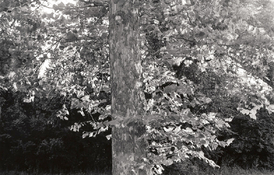I have many many examples why HP5 struggles with high contrast. I shot and printed a lot of HP5 in 8X10. It can really be lovely. For example, out along the coast when the fog is in, you get natural softbox conditions where HP5 ca perform superbly, but once the sun breaks out around noon or so in the redwoods, you've got an 11 or 12 stop range to contend with, which can be fascinating to compose with, but which also presents a real challenge for most films, including HP5.
So I'd typically go out with one 8X10 holder with HP5 in it, another holder with either TMax 400 or Bergger 200 in it, and a third holder with color film. But I found both HP5 and Bergger 200 too grainy to my taste for smaller 4X5 usage.
With care, TMY400 can handle 11 stop range without resorting to compressing or ZS minus tactics. Old Super XX could handle it fine, as well as Bergger 200, but not HP5, not even FP4 or Delta 100, although there are ways of improving all of those in such cases. With HP5, I'd use supplementary masking, which in effect is the original version of curve control, yet with added benefits like precise control of edge effect, along with a certain amount of automatic dodging and burning if produced with that in mind. But even then, it's no match for TMax films in the first place.
If you are of a one-film mindset, then by all means, figure out every realistic trick you can do with it. I've discovered that TMY is a far more versatile film than HP5, and I don't need to worry about its grain in smaller formats. But I still often resort to other films like HP5 and FP4 for their own features and signature look, as well as for sake of their gentler price point. I generally keep FP4 and TMX100 on hand for masking and duplicating purposes, so might as well shoot some of that too. Fuji Acros has been another favorite, and in small formats, all kinds of things including Pan F once in awhile, and when it was still around, a lot of Efke R25, which itself had a very long scale film (just the opposite of Pan F with its exaggerated S-curve and very limited contrast scale better suited to falling snow and rain or beach fog). All of them can produce excellent prints if wisely used.
So I enjoy working with all kinds of films; but I learned a long time ago the merits of a "straight line" film when that's what you really need. Of course, it's all relative. Straight line films have a toe too; it's just very short. Or I should say, they had a very short toe, in the past tense. Foma 200 is a last straight line film still around, but is no substitute for the flexibility of the "Rest in Peace" 200's. So yeah, if Super XX could be reincarnated, I'd buy it.





 I am closer to the Ilford community due to geography/history, but what you've described reminds me of the Delta vs HP5+ split in this camp. Either way, I agree that the choices we still have in the B/W market are pretty fantastic, and I haven't even tried some options like the ADOX products.
I am closer to the Ilford community due to geography/history, but what you've described reminds me of the Delta vs HP5+ split in this camp. Either way, I agree that the choices we still have in the B/W market are pretty fantastic, and I haven't even tried some options like the ADOX products.
